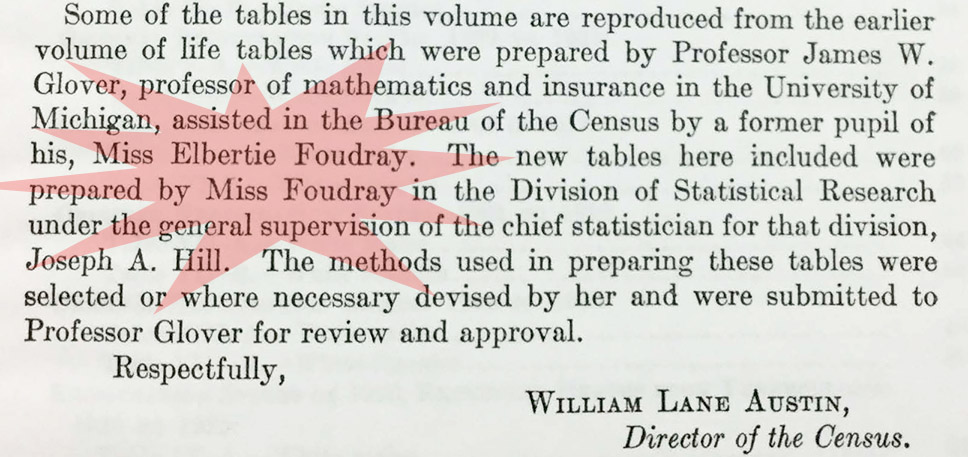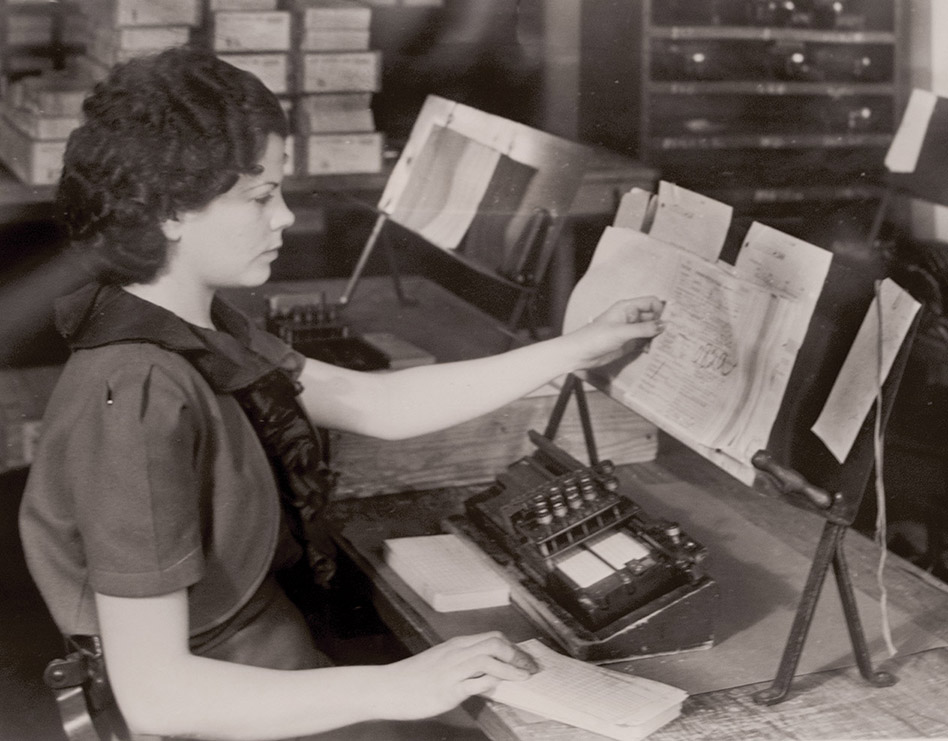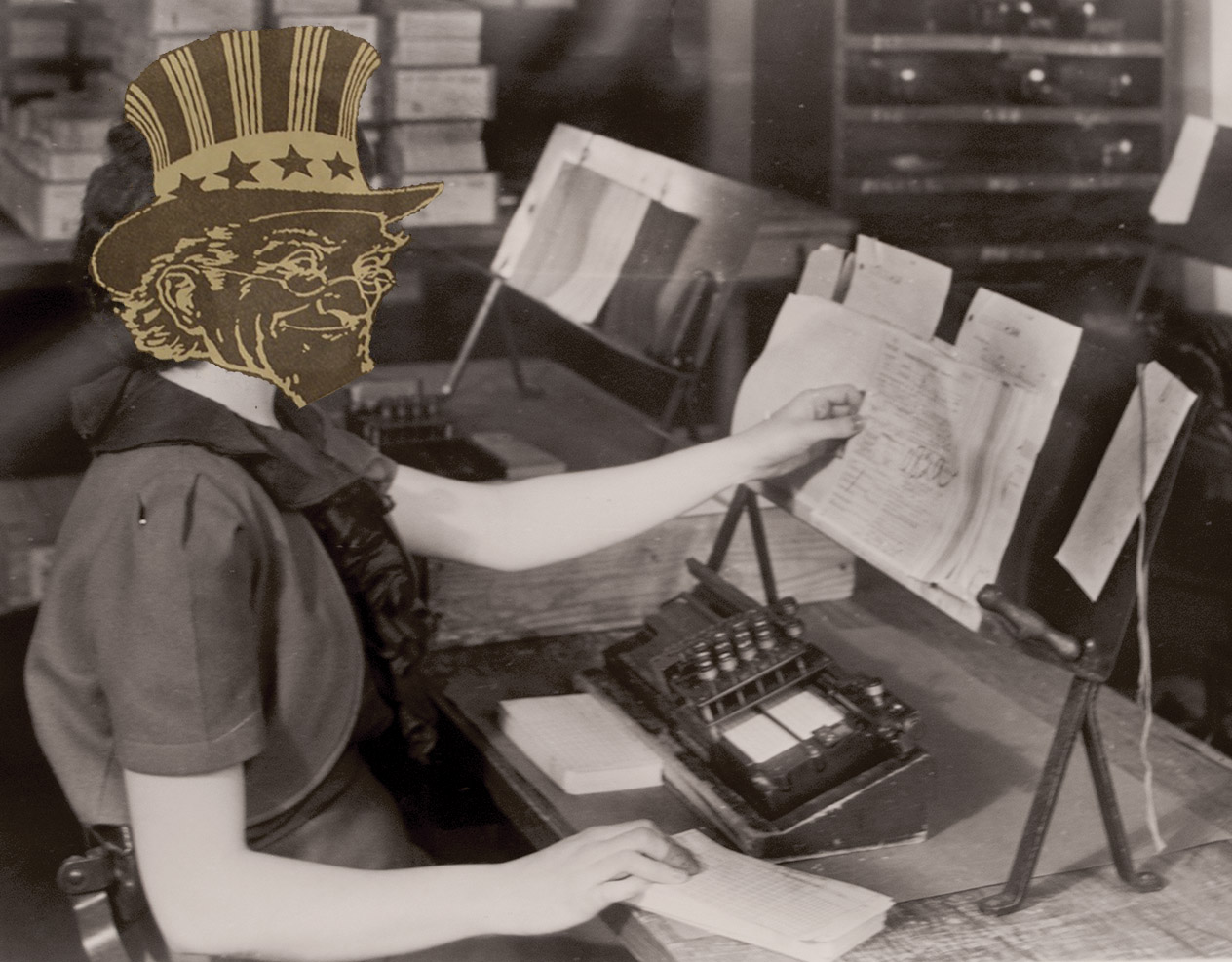Elbertie Foudray and the Adventure of Life
Historians believe in contingency—we insist that the past did not have to turn out the way that it did, that chance occurrences and human choices send the world spinning along one path and not another. So too, contingency governs our research about the past. I never set out to write a book about the dream in 1940 of devising the most scientific census ever. Instead, I went looking for an obscure census mathematician named Elbertie Foudray and, to my surprise, discovered the census. This is a census story all about chance and gender (as well as power) and it began with an effort to recreate a very odd paper machine.
In the mid-1930s, Alfred Lotka decided to build a model of the United States population. How does one model an entire population? Lotka’s method might seem more fitting for a board game than serious social science^: he built spinning wheels. (Really, he had them built by unnamed staff in the Metropolitan Life’s division of mathematical research, which he directed. Lotka authored key theories in ecology and demography, but anti-semitism denied him an academic career. Metropolitan, in contrast, welcomed him.)
I’ve found no trace of those wheels in the archives. But I think they could have looked like this:

Abby Balfour, Erin Burke, and Christy Mills—three undergraduate researchers working in my history lab^^—snuck with me into the Colgate University art studios one afternoon to build the wheels pictured above. We worked from Lotka’s explanation in a 1934 book, published first in French and only translated to English in 1998. As the wheels spun, they created a hypothetical statistical population, one ruled by gender (and race too).
Every experiment began by spinning a wheel that predicted the age at which a (hypothetical) white man would die. With his death foretold, he came to life. Another spin of a different wheel married him off at whatever age the needle stopped. That marriage created a white woman—a secular parallel to the Hebrew Bible’s story of the creation of Eve from Adam’s rib. Subsequent wheels determined how old each new Eve would be when she gave birth to a Cain or an Abel, although the sex of each child actually depended on—you guessed it—the spin of a wheel.
The shaded sectors on each wheel represented the likelihood of each life event. The one sitting on top is a mortality wheel divided according to the likelihood that a white American woman would die at any given age. The blue slice in the foreground—by far the largest of them all—represented those children who never lived to see their first birthdays.
Lotka required United States “life tables” (also called “mortality tables”) to make his wheels. Each life table explained what proportion of people in a population died, on average, at each age. As my history lab set out to re-create the wheels, we needed to find the life tables at the heart of Lotka’s work. We did—and I was struck by the author’s name: Elbertie Foudray.

Lotka’s wheels depended on the expert statistical labor of woman working for the Census Bureau, but I had never heard much about women working for the Bureau and never once encountered this name. Who was Elbertie Foudray?
In the archives, one can readily see women working for the Census. In a very limited way…
Consider this photograph from 1939 or 1940:

When I look at this picture, my eyes fly first to a person’s face, to a ruffled collar, to meticulously styled hair. Then I notice the papers she’s grasping—a thick stack, marked up all over. Finally, I notice a small mechanical device. In sum, I see a census clerk preparing paper punch cards—like the one she’s grabbing with her right hand. I see a working woman in a knowledge factory, one body in the human treadmill that transforms enumerators’ completed schedules into bound volumes of printed statistics.
The official caption for the photo, in contrast, says:

This is a card puncher… To Bureau officials, the subject of the photo was the machine, not the person.
You might be thinking: sure, but card puncher is probably just an old-timey job category. People (more precisely, women) used to be typewriters. They used to be computers. Why not card punchers?
While possible, the rest of the evidence argues against that interpretation. For one thing, the series of photos in which I found this one displays and names pieces of machinery (like this electronic tabulator), but never discusses the (mainly female) workers who appear with the machines. The caption text offers further support for my reading of this image. Did you catch the passive voice in the second sentence: “Holes are punched…”—not the “She punches…” we’d expect if the person were the “card puncher.”
An old internet friend^^^, Rachel Leow takes gorgeous pictures of gorgeous libraries, calling her work “bookporn.” When I see images like this one, I think of it as “machineporn”—not because the person in the photo has been sexualized. No, instead the purpose of the person seems to be to better show off the capacities of the machinery. In the book Programmed Inequality, historian of computing Marie Hicks, explains how advertisements from the 50s in Britain used women in such ads to stand in for perfectly fungible, feminized office staff. They help employers to imagine that their own female clerks will be able to use the machines easily—the ads sell the machine and erase the skill needed to operate it, which makes it okay to pay the operator less.
Hicks writes:
Far from being positioned as ‘cheesecake’ to help attract attention to the machines, the women workers were used simply as placeholders for the company’s own staff… (116)
The census “machineporn” showed off the U.S. government’s modernity. To be modern meant employing both new technologies and underpaid women. The individual in the photo did not matter. Who tabulated the census results?
Uncle Sam did.

Women rendered nearly invisible by the administrative archive also did the counting. Nearly half of all enumerators in 1940 were women, but they mostly go unnamed in official records and histories. They can be discovered, though, through the enumeration schedules they completed—there, on documents meant to record the lives of others, I’ve (so far) found evidence of the work of women like Lucile Kenn, Mollie Levi, and Mary Rupp. That leaves more than 50,000 women workers’ stories still untold. Half of those listed their occupation as “housewife.” To count Americans, the government drew on a reserve of ready, domestic labor.

One might write off these erasures as inconsequential, as mere representational fluff (I wouldn’t, but one might)—yet erasing and ignoring women workers in publicity and records went hand-in-hand with systematically limiting their opportunities for advancement. Only one women won an appointment as an “Area Supervisor.” The highest rank most women could reach in the army of counters was that of assistant district supervisor. Among women of color, racism amplified sexist discrimination to bar the path to census work. Bureau records describe fewer than 2% of enumerators as “non-white.” Race and sex stacked the odds in this bureaucratic game of life.
Elbertie Foudray did well playing an unfair game.
Between 1920 and 1945, she became one of the United States’ most important actuaries. World class experts scheduled meetings to talk statistics with her. The life insurance industry, the developing welfare system, and the first generation of American state planners all relied on her research. Foudray’s reputation grew. And her salary also grew too. Still she did not earn even half as much as she should have and despite two decades of celebrated service and significant responsibility, Foudray couldn’t escape the ranks of the “assistant” class.
Foudray was born in Sweet Springs, Missouri on 30 September 1878. She belonged to a Methodist Episcopal church and spent 4 years in high school before taking a B.S. degree from Northwestern University. Much of what I have come to learn about Foudray lay waiting to be discovered in Northwestern’s alumni biographical files, shared graciously with me by Assistant University Archivist Janet C. Olson. Many—maybe all—universities keep alumni files that help them tout their alumni’s accomplishments and also pump them for cash. As alumni pass away, the files lose financial value to the university but become peerless resources for peering into the lives of America’s educated middle classes.
Foudray’s college application, preserved in her file, asked: “What do you purpose to do after graduation?” She said that she would teach. And she did, for a little while. After graduating Phi Beta Kappa and despite battling poor health, Foudray took positions in Michigan and Montana teaching math and science. But that work must not have satisfied her. Foudray went back to Northwestern for graduate courses, and then on to the University of Michigan.
Foudray’s time at Michigan did not lead to a graduate degree. Self-diagnosed “stage fright” during oral exams kept her from getting a Master’s degree at first. Then when the University of Michigan dropped the oral exam requirement a year later and offered Foudray the degree, she declined it. At that point “the $10 [for a processing fee] appealed to me more than the degree,” she explained. Instead her work as assistant to James W. Glover, the single most influential teacher of actuaries in the United States, brought Foudray to the nation’s capitol. Glover took on the task of building life tables premised on “registration data”—records of births and deaths kept by state registrars—instead of on decennial census counts. He sent Foudray and a “section of clerks” to D.C. to gather data and begin making the necessary computations.
The work required patience and determination, as well as mathematical smarts. “About nine tenths of Life Table construction in those days was examining what data was available, testing it for accuracy, correcting it before using, and trying to get extra data where no census data was available,” Foudray later explained. Over the years, Foudray developed tests for the accuracy of registration data, like when she made “extensive comparisons of birth certificates and reported deaths of infants under one year with the census records of infants in the District of Columbia.” The title page of a Government Printing Office book from 1923 and an official note prefacing a book from 1936 furnish lasting evidence of Foudray’s labors: they bear her name.^^^^
Foudray did not lack for skill or confidence in advanced mathematics. On the contrary, she inserted herself into conversations at the field’s cutting edge in the 1920s. According to Foudray, the Bureau’s Chief Statistician—William H. Davis—assigned her to master Karl Pearson’s theory of “multiple correlation.” He sent Foudray to Johns Hopkins to study the theory (I suspect from Raymond Pearl). But in what can only be described as a remarkable show of intellectual independence, Foudray judged the proofs behind the technique to be lacking. “I met only impatience when I tried to get a fuller proof,” she wrote. And so: “I advised against its use in the Census Bureau.”
In many ways, Foudray resembles one of the “hidden figures,” whose stories Margot Lee Shetterly so wonderfully told and director Theodore Melfi brought, with delightful verve, to a theater near you. Even though Foudray’s whiteness extended her privileges not available to Dorothy Vaughan, Mary Jackson, or Katherine Johnson, like them she made crucial contributions to a major national project only to have those contributions forgotten. Also like those later individuals, Foudray’s work involved its own moral complexities. Those who only watched Melfi’s film might be surprised to learn that its protagonists spent most of their careers—and did some of their most significant work—as employees of NACA (NASA’s predecessor), where they labored to build more powerful weapons of war. The film focuses on conquering space and so ignores the fighter jets that Vaughn, Jackson, Johnson, and their colleagues developed for conquering on Earth. Foudray’s longest single project came early in her time at the Census Bureau, when she labored to calculate precisely the racial composition of the entire population at the behest of Congress and her boss, Joseph Hill. Her calculations were meant to justify strict quotas keeping out most southern and eastern Europeans, while barring people of color entirely. Foudray recognized the racism motiving this task, despite its objective, non-racist veneer: “It was not exactly racial for it was based on census records of Country of birth…but it was close enough to be called racial.” Still, she also sounded annoyed when, having completed her work, the State Department ignored it.
America’s elite population researchers trusted Foudray, identifying her with her tables. They trusted “the Foudray life tables,” which appeared in multiple / key / works of interwar demography. When Foudray (rather typically, it seems) challenged some assumptions made in calculations by Pascal K. Whelpton—the most important population forecaster of the day—he responded that he “surely will see Miss Foudray the first time I am in Washington…” He took her seriously.
Non-experts needed Foudray’s help too. She recalled:
When not actually at work on life tables, so much of time was taken up answering questions that involved the use of life tables. There were very few actuaries in the Government at that time, and so most letters with this type of question were turned over to the Census Bureau for reply.
Foudray sacrificed research time to serve other scholars, bureaucrats, and the public. She mourned her lost productivity.
In the 1920s, Foudray enjoyed the title of Expert Special Agent. But even that title could make her invisible. The Social Security Board’s assistant actuary went out of his way to avoid naming Foudray. In a 1940 paper on the role played by actuaries in the government, he repeatedly mentions “Dr. Glover” as author and then overseer of the tables. Foudray appears anonymously as “an Expert Special Agent of the Census.” By then, Foudray earned more money but lacked career mobility. In July 1940, the Division of Statistical Research hired an actuary to serve as Foudray’s superior—Thomas N. E. Greville—dooming her to languish as an Assistant Economic Analyst, even as the work she did remained essentially actuarial. Foudray’s consolation prize, delivered on a few months earlier on April Fools Day 1940, had been a $200 raise to $3,200 a year. That made Foudray the second-highest-paid woman in the Division, ahead of many younger men, but still receiving only around half that earned by a full “analyst.” As an assistant, Foudray wrote extensive, knowledgable letters on behalf of Greville or the Chief Statistician Cal Dedrick. Yet knowing recipients were in on the game. A University of Chicago sociologist received a ghost-written letter, ostensibly from Dedrick, and replied: “May I congratulate you and Miss Foudray…”
In a photo sent to her Alma Mater, Foudray omitted the assistant tag: she presented herself as simply an “Economic Analyst.” When a Northwestern alumni information form asked for her occupation, Foudray did not even bother with titles. She explained instead what she did:
Retired 1945 [In charge of LIFE TABLES, Census Bureau, U.S. Govt.]
The U.S. civil service relegated Foudray to permanent assistant-hood, but Foudray claimed the credit she deserved and named her occupation properly. She was in charge of life tables.
In 1934, Alfred Lotka gave a public lecture at Johns Hopkins University titled “The Adventure of Life.” Presenting one statistical example after another, Lotka made the case that life succumbed to prediction more than his listeners might have expected. Still, he carved out room^^^^^ for individual choice and agency:
Life is not wholly a game of skill. But neither is it wholly a game of chance. It is something of both: that is what for us makes life an adventure. But it is a purposeful adventure. And intensity of purpose can make it a heroic adventure. (3)
Foudray lived life with intensity and purpose. She took charge of the United States life tables. She refused to blindly accept proofs of multiple correlation and challenged acclaimed population experts like Pascal Whelpton. She cared about politics too. After her retirement, Foudray listed “genealogy” as a hobby, along with an “intense interest in current life of the Nation.”
But apart from skill and chance, power also shapes a life. Frustration plagued Foudray. Some were the ordinary frustrations of functionaries: years spent in calculation were tossed away by political considerations. Other frustrations stemmed from Foudray’s sex. Discrimination denied her recognition, compensation, and promotion.
Asked to list the “Highlights of your life since leaving” Northwestern University, Foudray’s response dripped with the pain of dreams disappointed:
Making a living while fighting off ill health.
Was this a heroic life? I’m not sure.
I am certain of this: it was a life worth remembering.
Elbertie Foudray’s story convinced me that her’s was one of many stories of extraordinary people who made possible the massive project of counting a nation. Uncle Sam—in point of fact—can’t do much. These census stories are dedicated to all those workers, like Foudray, who have been forgotten, but whose efforts deserve our attention.
^ Then again, modern probability theory developed in part from the efforts of mathematicians and philosophers, like Pascal or Fermat, to work out legal or equitable ways for wealthy gamblers to divide the pot of winnings when it came time to call it a night. (For the bigger picture, see Lorraine Daston’s Classical Probability in the Enlightenment)
^^ Balfour, Burke, and Mills deserve credit for giving these wheels substance. My lasting thanks to them for their intelligence, skill, and patience! And thanks to artist Wenhua Shi for getting us situated and supplied!
^^^ I “met” Rachel—now a historian at Cambridge University with an award-winning book out—in the Snarkmatrix, which is to say we got know each other through the comment threads of a very smart blog of the late aughts: Snarkmarket. We aren’t pen pals, but maybe blog buddies?
^^^^ Yet the 1936 book doesn’t name Foudray on the title page, instead choosing Joseph Hill to credit for “supervising” the construction of all the tables. The reasoning here must have been that Foudray did not author the earliest tables: Glover did. Yet even Glover’s tables were, to some significant degree, Foudray’s work.
^^^^^ Of course, that room appears to have mostly existed at tiny scales—think: quantum mechanics. Only among the protons and electrons did Lotka find enough indeterminacy to justify his own faith in free will and his devotion to Ralph Waldo Emerson.